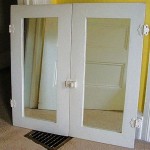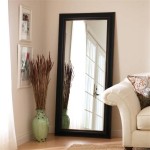Painting on a Mirrored Closet Door: A Comprehensive Guide
Mirrored closet doors are a common feature in many homes, offering a sense of spaciousness and providing a full-length reflection. However, these doors can sometimes feel outdated or simply not align with a desired aesthetic. Instead of replacing the entire door, painting the mirror surface offers a cost-effective and relatively straightforward way to transform the look of a room. This article provides a detailed guide on how to successfully paint a mirrored closet door, covering preparation, materials, application, and potential challenges.
Surface Preparation: The Foundation for a Lasting Finish
Proper surface preparation is paramount for ensuring that the paint adheres correctly to the mirror and provides a durable, long-lasting finish. Skipping or skimping on these steps will likely result in peeling, chipping, or an uneven appearance. The process involves cleaning, etching, and priming the mirror surface.
The first step is thorough cleaning. Use a glass cleaner, such as a commercial window cleaner or a mixture of vinegar and water, along with a lint-free cloth to remove any dirt, grime, fingerprints, or residue from the mirror surface. Multiple passes may be necessary to ensure a completely clean surface. Avoid using cleaners with silicone, as this can interfere with paint adhesion. After cleaning, allow the mirror to dry completely.
Next, the mirror surface must be etched to create a slightly rough texture that the primer can grip onto. This etching can be achieved through several methods, each with its pros and cons. One option is to use a specialized etching cream designed for glass. Apply the etching cream according to the manufacturer's instructions, typically covering the entire surface to be painted. Allow the cream to sit for the recommended time, then rinse it off thoroughly with water and dry the mirror completely. Another method involves using fine-grit sandpaper (e.g., 220-grit or higher) to lightly sand the surface. This approach requires careful and even sanding to avoid creating deep scratches. It's crucial to maintain light pressure and use circular motions. After sanding, wipe away the dust with a damp cloth and let the mirror dry.
After etching, the application of a bonding primer is crucial. Bonding primers are specifically formulated to adhere to slick, non-porous surfaces like glass and metal. It bridges the gap between the smooth mirror surface and the paint, creating a strong bond. Choose a high-quality bonding primer specifically designed for glass or multi-surface applications. Apply the primer in thin, even coats, following the manufacturer's instructions regarding drying time between coats. Typically, two coats of primer are recommended to ensure adequate coverage and adhesion. Allow the primer to fully cure before proceeding to the painting stage. This curing time is essential for optimal bond strength and preventing future peeling. Consult the primer's product information for specific curing recommendations.
Selecting the Right Paint and Application Techniques
Choosing the appropriate paint for a mirrored closet door is as important as the preparation. Not all paints are created equal, and some are better suited for this application than others. The type of paint, finish, and application method all contribute to the final outcome. The application should be done in a well-ventilated area, even when using paints labeled as low-VOC.
Acrylic latex paints are generally a good choice for painting mirrored surfaces. They offer good durability, are relatively easy to clean, and are available in a wide range of colors and finishes. Avoid oil-based paints, as they tend to yellow over time and may not adhere as well to the primed surface. Consider the intended use and aesthetic when selecting the paint finish. Semi-gloss or gloss finishes are more durable and easier to clean, making them suitable for high-traffic areas or doors that are frequently touched. Matte or eggshell finishes offer a more subtle appearance but may be less resistant to scuffs and stains.
Application techniques greatly affect the final look of the painted mirror. Applying the paint in multiple thin coats is preferable to applying one thick coat. Thin coats dry more evenly, reduce the risk of drips and runs, and ultimately result in a smoother, more professional finish. Use high-quality brushes, rollers, or spray equipment for the application. For brush application, choose a brush with synthetic bristles, as natural bristles can leave brushstrokes. When using a roller, opt for a fine-nap roller to minimize texture. Spray painting provides the smoothest finish, but it requires proper equipment, ventilation, and masking to protect surrounding surfaces. If using spray paint, apply light, even coats, overlapping each pass slightly. Allow each coat to dry completely before applying the next. Sanding lightly between coats with very fine-grit sandpaper (e.g., 400-grit or higher) can help to smooth out any imperfections and improve adhesion of the subsequent coat. Remember to wipe away any sanding dust before proceeding.
Masking is another critical aspect of the painting process. Use painter's tape to carefully mask off any areas that are not to be painted, such as the door frame, hinges, or handles. Ensure that the tape is firmly adhered to the surface to prevent paint from bleeding underneath. Consider using drop cloths or plastic sheeting to protect the surrounding floor and furniture from paint splatters or overspray.
Allow the paint to fully cure according to the manufacturer's instructions. Curing time is typically longer than drying time, and it is essential for the paint to reach its maximum hardness and durability. Avoid handling or cleaning the painted surface until it is fully cured.
Addressing Potential Challenges and Ensuring Durability
Painting a mirrored closet door can present several challenges, from paint adhesion issues to the potential for scratches and chipping. Understanding these challenges and taking proactive steps can help ensure a successful and long-lasting result.
One common issue is poor paint adhesion. This is often caused by inadequate surface preparation. If the mirror is not properly cleaned, etched, or primed, the paint may not adhere correctly, leading to peeling or chipping. To prevent this, meticulous attention to surface preparation is crucial. Using a high-quality bonding primer and following the manufacturer's instructions diligently is also essential. If adhesion problems occur despite proper preparation, consider stripping the paint and starting over.
Scratches and chipping are another potential concern, especially in high-traffic areas. Choosing a durable paint finish, such as semi-gloss or gloss, can help to resist scratches and scuffs. Applying a clear coat over the painted surface can also provide added protection. Polyurethane or acrylic clear coats are good options, providing a hard, durable finish that is resistant to scratches and chemicals. Apply the clear coat in thin, even coats, following the manufacturer's instructions regarding drying and curing times.
Uneven paint coverage or brushstrokes can also detract from the overall appearance. This can be avoided by applying multiple thin coats of paint rather than one thick coat. Using high-quality brushes or rollers, or opting for spray painting, can also help to achieve a smoother, more even finish. Sanding lightly between coats can help to smooth out any imperfections and improve adhesion of the subsequent coat.
Humidity and temperature can also affect the painting process. Avoid painting in excessively humid or cold conditions, as this can affect the drying time and adhesion of the paint. Ideally, paint in a well-ventilated area with moderate temperature and humidity levels. Ensure that adequate ventilation is present to allow for proper drying and to minimize the risk of inhaling paint fumes. Wear appropriate personal protective equipment, such as a respirator or mask, when painting, especially when using spray paint.
In some cases, the existing mirror may have imperfections, such as scratches or blemishes. While paint can conceal minor imperfections, it may not completely hide deeper scratches or damage. Consider filling any significant imperfections with a glass filler before painting. Apply the glass filler according to the manufacturer's instructions, allow it to dry completely, and then sand it smooth before priming and painting.
Finally, consider the long-term maintenance of the painted mirror. Clean the surface regularly with a mild cleaner and a soft cloth. Avoid using abrasive cleaners or scouring pads, as these can scratch the paint. Touch up any chips or scratches promptly to prevent further damage. With proper preparation, application, and maintenance, a painted mirrored closet door can provide a beautiful and durable update to any room.

Sliding Closet Door Makeover With Paint Tape Making Maanita

Sliding Closet Door Makeover With Paint Tape Making Maanita

Diy Closet Door Spray Paint Update By Claudya

Sliding Closet Door Makeover With Paint Tape Making Maanita

20 Diy Closet Mirror Door Makeover Angela Rose Home

Refinishing Gold Mirrored Closet Doors Frugalwoods

Diy Closet Door Spray Paint Update By Claudya

How To Update Mirrored Closet Doors The Good Bad And Ugly

Design Solutions For Outdated Mirrored Closet Doors

Mirrored Closet Door Makeover








